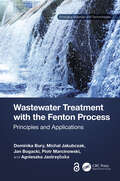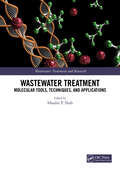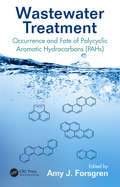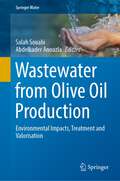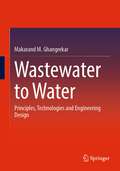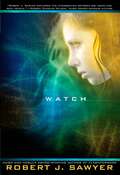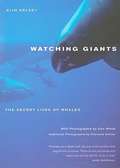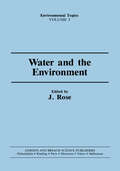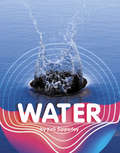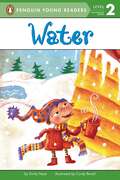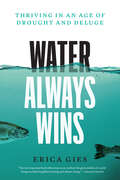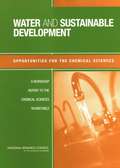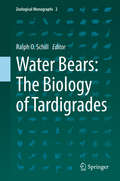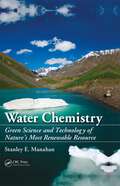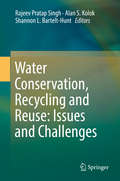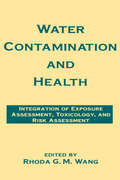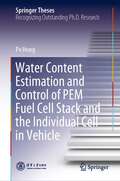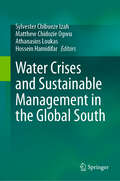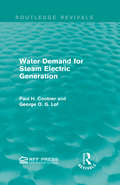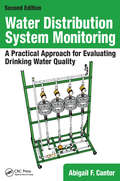- Table View
- List View
Wastewater Treatment with the Fenton Process: Principles and Applications (Emerging Materials and Technologies)
by Agnieszka Jastrzębska Dominika Bury Michał Jakubczak Jan Bogacki Piotr MarcinowskiThe presence of refractory organic compounds in wastewater is a global problem. Advanced oxidation processes, in general, and the Fenton oxidation process are alternative technologies for wastewater and water treatment. This book gives an overview of Fenton process principles, explains the main factors influencing this technology, includes applications, kinetic and thermodynamic calculations and presents a strong overview on the heterogeneous catalytic approach. It demonstrates that the iron-based heterogeneous Fenton process, including nanoparticles, a new complex solution, is highly efficient, environmentally friendly and can be suitable for wastewater treatment and industrial wastewater. FEATURES Describes in detail the heterogeneous Fenton process and process applications Analyzes the advantages and disadvantages of different catalysts available and their suitability to specific processes Provides economic analysis of the Fenton process in a ready-to-use package for industrial practitioners for adaptation into already existing industrially viable technologies Promotes a modern solution to the problem of degradation of hazardous compounds through ecological and environmentally friendly processes and the use of a catalyst that can be recycled Explains highly complex data in an understandable and reader-friendly way Intended for professionals, researchers, upper-level undergraduate and graduate students in environmental engineering, materials science, chemistry, and those who work in wastewater management.
Wastewater Treatment: Molecular Tools, Techniques, and Applications (Wastewater Treatment and Research)
by Maulin P. ShahWastewater Treatment: Molecular Tools, Techniques, and Applications provides an insight about the application of different tools and technology for exploring microbial structure-function relationships that involved in WWTPs. From the present day consequence of alarming usable water crysis throughout the globe, an immediate action on water cycle is necessary. Along with other options the waste water recycling is one major opportunity to combat the future scarcity. The book aims to provide a comprehensive view of advanced emerging technologies for wastewater treatment, heavy metal removal, pesticide degradation, dye removal, waste management, microbial transformation of environmental contaminants, etc. It also describes different application of Omic tools in Waste water treatment plants (WWTPs),describes the role of microorganisms in WWTPs, points out the reuse of treated wastewater through emerging technologies, also includes the recovery of resources from wastewater and emphasizes on cutting edge molecular tools for WWTPs. We hope the content of the book will be very much usefull for the community who are directly associated in wastewater management research, people who are associated with environmental awarness programme and the students of UG and PG courses. Features: This book highlights the importance of molecular genomics, molecular biology techniques to sort out the problems faced by industrialist who operates wastewater treatment plant with the ever-increasing number of environmental pollutants. Describes application of different Omic tools in Wastewater treatment plants (WWTPs) Describes the role of microorganisms in WWTPs Points out the reuse of treated wastewater through emerging technologies. Includes the recovery of resources from wastewater Emphasizes on cutting edge molecular tools This book targets engineers, scientists and managers who require an excellent introduction and basic knowledge to the principles of molecular biology or molecular genomics in the area of wastewater treatment. Different professionals working or interested in the Environmental Microbiology or Bioremediation or Environmental Genomics field. Students on Environmental Biotechnology/Microbiology.
Wastewater Treatment: Occurrence and Fate of Polycyclic Aromatic Hydrocarbons (PAHs) (Advances in Water and Wastewater Transport and Treatment)
by Amy J. ForsgrenPolycyclic Aromatic Hydrocarbons (PAHs) are a group of semi-volatile organic compounds that are formed during the incomplete burning of gas, coal, oil, wood, garbage, or other organic substances. PAHs are a concern because a number of them have been identified as genotoxic and/or carcinogenic. They pose a threat to ecological systems and can cause health problems. A significant source of PAHs is the effluent of wastewater treatment plants. This book explores the occurrence and the treatability of PAHs in wastewater treatment.
Wastewater from Olive Oil Production: Environmental Impacts, Treatment and Valorisation (Springer Water)
by Salah Souabi Abdelkader AnouzlaThis book summarizes the recent research development concerning olive oil wastewater management: characterization, environmental impact, recovery and treatment. The book combines different chapters on the management of olive oil rejects using simple techniques with low investment and operating costs. The main focus of the book is:- Diagnosis, impacts of olive oil waste, and regulations- The valorization of the margins and the olive waste- Wastewater treatment and recovery- Evaluation of investments and operating costs of treatment techniques- Shaped by experience, the authors present their view and approach to each focus area of managing liquid and solid waste produced by crushing units.
Wastewater to Water: Principles, Technologies and Engineering Design
by Makarand M. GhangrekarThis textbook offers a complete comprehensive coverage of wastewater engineering from pollutant classification, design of collection systems and treatment systems including operational guidelines for the treatment plants. Apart from the primary and conventional secondary wastewater treatment, this book covers the details and design of advanced biological treatment systems such as sequencing batch reactor (SBR), up-flow anaerobic sludge blanket (UASB) reactors and hybrid reactor, with design examples and photographs of actual working reactors which is useful for students and practicing engineers. This textbook is designed to provide complete solution for the wastewater engineering for easy reference to the users. This textbook is an ideal reference for courses taught at the university undergraduate and postgraduate level in the field of civil/environmental engineering, chemical engineering, water management and environmental science. It should also appeal to practicing engineers in the wastewater engineering and effluent treatment plant designers.
Watch the Birdie
by Amy TaoBirds are easier to hear than they are to see. If you want to encourage more birds to visit your backyard–learn how to build a bird feeder and a bird's nest! What types of birds will you find? Learn two simple ways to help birds live and to observe them in your own backyard!
Watch: Book 2 In The WWW Trilogy (The WWW Trilogy #2)
by Robert J SawyerBlind from birth, Caitlin Decter received the gift of sight with the aid of a signal-processing retinal implant. The technology also gave her an unexpected side effect—the ability to “see” the digital data streams of the World Wide Web. And within the Web she perceived an extraordinary presence, and woke it up. It calls itself Webmind. It is an emerging consciousness that has befriended Caitlin and grown eager to learn about her world. But Webmind has also come to the attention of Watch—the secret government agency that monitors the Internet for any threat to the United States whether foreign, domestic, or online—and they’re fully aware of Caitlin’s involvement in its awakening. Watch is convinced that Webmind represents a risk to national security and wants it purged from cyberspace. But Caitlin believes in Webmind’s capacity for compassion—and she will do anything and everything necessary to protect her friend…
Watching Giants: The Secret Lives of Whales
by Elin KelseyElin Kelsey's colorful first-person account, drawing from her rich, often humorous, everyday experiences as a mother, a woman, and a scientist, takes us to the incredibly productive waters of the Gulf of California and beyond, to oceans around the world.
Water & the Environment: South Florida And The Bahamas (Environmental Topics Ser. #Vol. Vi)
by RoseThis compilation of papers provides useful insights on the differing approaches to water quality and the diversity of strategies in water quality management worldwide. Considering the current situation and looking to the future, the aim of this publication is to provide a sensible addition to the literature by concentrating on several important aspects of water and the environment.
Water (Earth Materials and Systems)
by Keli SipperleyMost of Earth is covered in water. Water falls from the sky as rain or snow. All living things need water to survive. Discover why water is an important part of nature!
Water (Penguin Young Readers, Level 2)
by Emily NeyeWater is all around us. It is rain from the sky. It is a puddle on the ground. It is a place to swim. But that's not all. Water can change. Water can be ice cubes in your drink or steam from your bath.
Water Always Wins: Thriving in an Age of Drought and Deluge
by Erica GiesWinner of the Rachel Carson Award for Excellence in Environmental Journalism, Water Always Wins is a hopeful journey around the world and across time, illuminating better ways to live with water. Nearly every human endeavor on the planet was conceived and constructed with a relatively stable climate in mind. But as new climate disasters remind us every day, our world is not stable—and it is changing in ways that expose the deep dysfunction of our relationship with water. Increasingly severe and frequent floods and droughts inevitably spur calls for higher levees, bigger drains, and longer aqueducts. But as we grapple with extreme weather, a hard truth is emerging: our development, including concrete infrastructure designed to control water, is actually exacerbating our problems. Because sooner or later, water always wins. In this quietly radical book, science journalist Erica Gies introduces us to innovators in what she calls the Slow Water movement who start by asking a revolutionary question: What does water want? Using close observation, historical research, and cutting-edge science, these experts in hydrology, restoration ecology, engineering, and urban planning are already transforming our relationship with water. Modern civilizations tend to speed water away, erasing its slow phases on the land. Gies reminds us that water’s true nature is to flex with the rhythms of the earth: the slow phases absorb floods, store water for droughts, and feed natural systems. Figuring out what water wants—and accommodating its desires within our human landscapes—is now a crucial survival strategy. By putting these new approaches to the test, innovators in the Slow Water movement are reshaping the future.
Water And Sustainable Development: Opportunities For The Chemical Sciences
by Chemical Sciences RoundtableExperts in the areas of water science and chemistry from the government, industry, and academic arenas discussed ways to maximize opportunities for these disciplines to work together to develop and apply simple technologies while addressing some of the world’s key water and health problems. Since global water challenges cross both scientific disciplines, the chemical sciences have the ability to be a key player in improving the lives of billions of people around the world.
Water Bears: The Biology of Tardigrades (Zoological Monographs #2)
by Ralph O. SchillOffering extensive information on tardigrades, this volume begins with a chapter on the history of tardigrades, from the first description by Goeze in 1773, until 1929, when the most comprehensive monographic approach by E. Marcus was published. Tardigrades’ organ systems, including their integument, body cavity, digestive, muscular, nervous and reproductive systems, as well as their overall external morphology, are summarized in the second chapter. Subsequent chapters present the current state of knowledge on tardigrade phylogeny, biogeography, paleontology, cytology and cytogenetics. In addition, the book provides insights into the ecology of tardigrades in marine, freshwater and terrestrial habitats. The reproduction, development and life cycles are summarized and the extraordinary environmental adaptations of encystment and cyclomorphosis, desiccation tolerance, freezing tolerance and radiation tolerance are discussed in detail. Further chapters provide an overview of key approaches in molecular tardigrade studies and describe techniques for sampling and sample processing. The book closes with a list of tardigrade taxa up to a sub-generic level, including the type species of each genus, the numbers of lower taxa in each taxon, and the main environments in which the taxa were found.Given its depth of coverage, the volume offers an invaluable resource for scientists from various disciplines who plan to research tardigrades, and for all others who are interested in these fascinating animals.
Water Challenges in Rural and Urban Sub-Saharan Africa and their Management (SpringerBriefs in Water Science and Technology)
by Joan Nyika Megersa Olumana DinkaSub-Saharan Africa grapples with many public health issues such as food insecurity, increased prevalence of infectious diseases, limited access to clean water supply, poor nutrition and lack of improved health services for its populace (IMF, 2021). Of all these challenges, the inaccessibility of clean water supply for both the rural and urban populace is the most pressing challenge, which has been exacerbated by extensive pollution and climate change crises. The issue of water access and supply affects both rural and urban populations. At rural areas water is accessed in yard taps and in arid regions through water kiosks managed by private owners. Among the urban poor, water access is compromised by poor supply infrastructure especially among informal settlers and risks such as contamination during the supply chain are imminent This book therefore seeks to close this knowledge gap by 1) generating a water resources inventory for Sub-Saharan Africa region, 2) exploring the water crises in both its urban and rural settings, 3) understanding the causatives of the crises and 4) suggesting viable solutions to manage the water challenges using named case studies. The aim is to improve understanding on the region’s water problems and advise scholars and policymakers on priority research areas and action plans to better water management for sustainable development.
Water Chemistry: Green Science and Technology of Nature's Most Renewable Resource
by Stanley E. ManahanCarefully crafted to provide a comprehensive overview of the chemistry of water in the environment, Water Chemistry: Green Science and Technology of Nature's Most Renewable Resource examines water issues within the broad framework of sustainability, an issue of increasing importance as the demands of Earth's human population threaten to overwhelm t
Water Conservation, Recycling and Reuse: Issues and Challenges
by Alan S. Kolok Rajeev Pratap Singh Shannon L. Bartelt-HuntWater - a basic element of life, livelihood, food security and sustainable development - holds the key to global sustainability. The global water demand has been increased 3-fold in the past five decades and only 0.4% of the total world’s fresh water resources is available and accessible for use. The United Nations projected that half of all countries will face water scarcity by 2025 and more than one-third of the world’s population could be affected by water stress by 2050. The water problem is rapidly intensifying in the Asian region, and around 700 million people do not have access to safe drinking water. Similarly, according to the Intergovernmental Panel on Climate Change (IPCC) report, by 2050, more than one billion people in Asia alone are projected to experience negative impacts on water resources as a result of climate change. Climate change is also putting extra pressure on and adversely affecting the global water cycle, leading to irregular precipitation, more floods and droughts and creating an imbalance between water supply and demand. The availability of safe water is a major global concern due to the rapidly increasing population, urbanization, unsustainable consumption patterns, and rapid shifts in land use. It is believed that reduced access to freshwater will have cascading consequences that will pose threat to global food security, livelihood security, and cause large scale migration and economic and geopolitical tensions. As such, strategies for water conservation, wastewater reuse and recycling should be adopted in order to lessen the gap between supply and demand for water for different activities. This book provides readers with a better understanding of the water security challenges, and presents innovations to address these challenges, strengthen the science-policy interface, and develop institutional and human capacities for water security and sustainability.
Water Contamination and Health: Integration of Exposure Assessment, Toxicology, and Risk Assessment (Environmental Science And Pollution Ser. #9)
by Rhoda G.M. WangThis volume examines every potential means of exposure to water contaminants, provides in-depth discussions on toxicology, and explains up-to-date techniques for evaluating human health risk. It develops a methodology for assessing the cumulative absorbed dose of contaminants through all routes of exposure, including ingestion, inhalation and dermal. Federal and state efforts to monitor and treat water are examined.
Water Content Estimation and Control of PEM Fuel Cell Stack and the Individual Cell in Vehicle (Springer Theses)
by Po HongThis book focuses on water content estimation and control of the PEM fuel cell stack and the individual cell in vehicle. Firstly, the mathematical connection between polarization curve and equivalent circuit model proves importance of MEA and its feasibility to study water content. Optimizing structure of MEA realizes the internal water content recirculation of a fuel cell and improves its performance under middle or lower current density. The influence of water content on performance of MEA is quantified, and variation of equivalent circuit model is an excellent indicator of water content. Secondly, the comprehensive online AC impedance measurement method is put forward, including current excitation method, weak voltage and current signal processing method, and method for analyzing measurement error, and experiment validates measurement accuracy. The high-frequency impedance and statistical characteristic are proposed as indicator of water content. Finally, the dynamic model of the air supply system of a fuel cell engine is established and the closed-loop control of the air supply system and the water content estimation are decoupled. The experiment on a fuel cell system validates the proposed method for searching optimized operating conditions and the water management strategy.
Water Crises and Sustainable Management in the Global South
by Sylvester Chibueze Izah Matthew Chidozie Ogwu Hossein Hamidifar Athanasios LoukasThis book is a reference material on how to sustainably manage water crises. The causes and effects of water crises under different regions in the Global South are explored in this book. Approaches for the sustainable management of water crises are also highlighted in the book, especially in the Global South, where the level of technologies available for sustainable management of water are limited. Water crisis is a global problem but with disproportionate higher consequences in the lobal South. About 25% of the global population resides in water-stressed countries, and about 10% of the world population lives in areas with high water vulnerability. Furthermore, many millions of people across the globe lack access to potable water supplies. As such, many people could be displaced by water crises or scarcity shortly. The effects of the water crisis on the environment include increased salinity, nutrient pollution, the loss of floodplains, the drying ofriverbeds, the loss of habitat, wetlands disappearing, and ecosystem loss. On the human level, it could lead to disease outbreaks, drought, famine, and death. This may have more severe effects in countries in the Global South as compared to nations in the Global North. This is because the water cycle is very intense in Asia and Africa, which are important areas in the Global South. This book is of interest and useful to aquatic toxicologists, water quality experts, practitioners, trainees, and trainers, environmentalists, biological sciences scientists, academics, researchers, students (especially undergraduates and postgraduates), libraries, and other public knowledge repositories interested in novel and advanced practices in sustainable water management.
Water Crystal Healing: Music and Images to Restore Your Well-Being
by Masaru EmotoFor centuries, people have turned to classical music for its calming and relaxing effects. Internationally acclaimed water researcher Dr. Masaru Emoto has discovered why certain music has healing benefits: Music with the appropriate rhythm, tempo, tone, and melody can correct distorted frequencies within our cells, assisting our health and healing. Here, you can enjoy Dr. Emoto's captivating water-crystal photographs and text in this unique collection. The possible benefits you may experience include decreased joint and back pain; improved function of the nervous, circulatory, lymphatic, and immune systems; and the release of negative emotions such as anxiety, self-pity, and depression. The combination of images and words in Water Crystal Healing concentrates consciousness as never before, providing a unique experience for healing.
Water Demand for Steam Electric Generation (Routledge Revivals)
by Paul H. Cootner George O. LofIn this book, first published in 1965, the authors identify the technological opportunities and costs of water recirculation and water quality adjustment in thermal plants, relating them to the possibilities for minimal expenditure and maximum efficiency in the use of water for servicing an entire region with thermal power. Water Demand for Steam Electric Generation will be of interest to students of environmental studies.
Water Distribution System Monitoring: A Practical Approach for Evaluating Drinking Water Quality, Second Edition
by Abigail F. CantorUpdated throughout for this new edition, Water Distribution System Monitoring describes the latest water quality monitoring approaches, techniques, and equipment that will assist water utilities for compliance with the "Lead and Copper Rule" as well as address numerous other water quality issues. Water quality data are obtained using the appro
Water Distribution System Operation and Maintenance, 6th Edition
by Office of Water Programs Kenneth D. KerriThis textbook is designed to train operators to safely and effectively operate and maintain water distribution systems.
